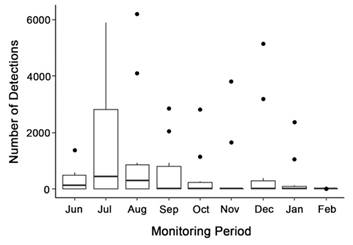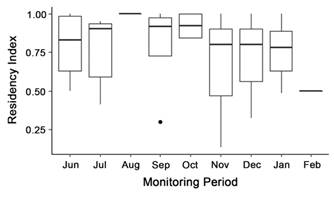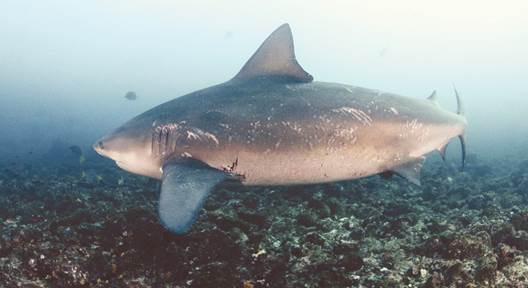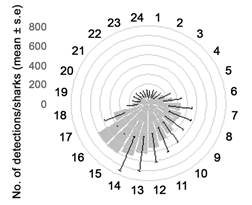Introduction
The Archipelago of Islas Murciélago is part of the Marine Sector of the Guanacaste Conservation Area, in the north Pacific of Costa Rica. One of the top predators of this area is the bull shark, Carcharhinus leucas (Valenciennes 1839), which is a cosmopolitan tropical and subtropical species commonly found in coastal ecosystems such as estuaries, lagoons, and river mouths thanks to their capacity to enter freshwater systems (Compagno, 1984). Like other elasmobranchs, the bull shark uses estuaries and river mouths as nurseries. The fact that these systems are also of high productivity could be one of the reasons why adult female bull sharks prefer these sites to give birth (Curtis, Parkyn, & Burgess, 2013). Several authors have reported bull sharks using coastal ecosystems for protection and food during their early life stages (Simpfendorfer, Greitas, Wiley, & Heupel, 2005; Werry & Clua, 2013). Nursery grounds for bull sharks have been documented in the Gulf of Mexico and the east coast of Florida (Curtis, Adams, & Burgess, 2011). Bull shark juveniles can access rivers to feed, preying on species that migrate between rivers and oceans during tidal changes. Numerous studies have also reported the preference or habitat fidelity of adult bull sharks to shallow waters of coastal habitats, particularly to those with a high input of freshwater, such as river mouths and estuaries (Bangley, Paramore, Shifman, & Rulifson, 2018; Brunnschweiler, Queiroz, & Sims, 2010 Carlson, Ribera, Conrath, Heupel, & Burgess, 2010; Graham et al., 2016; Heupel et al., 2015). The permanence of bull sharks in coastal ecosystems makes them vulnerable to anthropogenic actions like habitat degradation, pollution, and fishing exploitation (Curtis et al., 2013; Thorson, 1971; Werry & Clua, 2013).
Bull shark population depletion is reported in different places around the world, such as the Gulf of Mexico and the southwest Atlantic of Brazil (Almeida, McGrath, & Ruffino, 2001; Powers et al., 2013). In Central America, specifically in Lake Nicaragua, exploitation of bull sharks started in the 1960s, when they were consumed domestically and exported overseas (Thorson, 1982). In the 1970s an Asiatic shark fin processing plant started to operate near Granada. In Lake Nicaragua, the bull shark fishery industry collapsed in the 1980s, yet the population has still not recovered from overexploitation (McDavitt, 2002).
Bull sharks currently have a higher economic value as a tourist resource, related to recreational diving, than as a commercial species. For example, at Cabo Pulmo National Park (CPNP), Mexico, the bull shark is one of the main attractions for tourists. According to Pasos-Acuña (2018), bull shark recreational diving at CPNP represents more than $7.5 million each year. Worldwide, it is estimated that half a million people are interested in shark diving, generating more than US$314 million per year and more than 10 000 jobs. Furthermore, it is expected that in the next 20 years shark tourism is going to double at a global scale, potentially generating more than US$750 million annually (Cisneros, Barnes, Navarro, & Rashidsumaila, 2013).
In Costa Rica, bull shark juveniles and adults are occasionally caught by artisanal fishermen (bottom line and gill nets) who fish close to river mouths and estuaries (López, Arauz, Zanella, & Le Foulge, 2009; López & Zanella, 2015). The exploitation of bull sharks in Costa Rica has been developed without any specific management regulation. The San Pedrillo islet, located at Islas Murciélago archipelago, has been identified empirically as an aggregation site for bull sharks, the only one reported for the species in Costa Rica. During the rainy season (May-November), local communities such as Playas del Coco, Tamarindo, and Cuajiniquil, directly benefit from SCUBA diving with bull sharks in a completely natural environment (Davis & Klapfer, 2018). In this study, we used acoustic telemetry to monitor the residence of adult bull sharks at the San Pedrillo islet. This study will add new information for the design of conservation strategies to improve the protection of the bull shark population at the Conservation Area of Guanacaste and surrounding areas.
Materials and methods
Study area: The archipelago of Islas Murciélago is located in the north Pacific of Costa Rica, 5 km off mainland Costa Rica, and is comprised of five islands and ten islets, one of them being San Pedrillo (10º51’12.4”N & 85º57’32.5” W) (Denyer, Cortés, & Cárdenes, 2005). As part of the Área de Conservación Guanacaste (ACG, Guanacaste Conservation Area), the Islas Murciélago belong to a UNESCO World Heritage Site; part of the Sistema Nacional de Áras de Conservación (SINAC, National System of Conservation Areas of Costa Rica) from the Ministry of Environment of Costa Rica (SINAC, 2013). The archipelago is a no-take Marine Protected Area with an extension of 43 000 ha where only tourism activities are allowed. The marine biodiversity of Islas Murciélago is influenced by a seasonal upwelling (from December to March) that rises cold deep water masses that generate an intense effect on the distribution of nutrients and plankton (Jiménez, 2016; Rodríguez, Alfaro, & Cortés, 2021).
Acoustic array and shark tagging: Tagging was performed between June 2013 and September 2014 at San Pedrillo islet between 18 and 30 m depth, where the aggregation of adult bull sharks is known to occur (Davis & Klapfer, 2018). An acoustic receiver was deployed at the same site using SCUBA gear. The tags or acoustic transmitters were V16-4H with external cases (Vemco Ltd., Halifax, Nova Scotia, Canada), which were tethered to stainless steel darts. Scuba divers inserted the darts into the muscle of the bull sharks at the base of the first dorsal fin. The researchers reported the sex of each shark tagged (presence or absence of claspers) and estimated the size (total length) of the shark. The sharks were tagged during the rainy season when the upwelling is not occurring and ocean conditions favor diving activities and underwater tagging. Transmitters were set to be silent (delay) for a randomized period of 40 to 140 s between each pulse train and had a battery life of approximately 4 years. Each transmitter tag conveyed a specific code for an individual shark, and periodically emitted a pulse train of closely spaced 69 kHz pings detected by the receiver VR2W (Vemco Ltd., Halifax, Nova Scotia, Canada), which was deployed before tagging on the 12th of June 2013. The receiver was placed at a depth of 30-35 m in a sandy bottom close to the aggregation site, next to the San Pedrillo islet. The receiver was anchored on a 65 kg cement block attached to a stainless-steel cable and suspended in the water column (approximately 3-5m from the bottom) with a buoy. The receiver stored the information emitted from the transmitters (date, time of the detection, and transmitter number for each individual pulse train) along a 250-300 m radius, verified via range tests. The detection of the tags decreased abruptly after 250 m, and tags were not detected at distances greater than 300 m. Receiver data was downloaded approximately every 5 months, for 1.5 years (June 2013 to February 2015).
Data analysis: The data recorded by the acoustic receiver in San Pedrillo was downloaded using the software VUE version 2.0.6. Shark detections during the study period were plotted using the ‘ggplot’ package in R version 3.6.3 (R Development Core Team R, 2014). To determine whether an individual was present on any day close to the receiver, we set a minimum of three detections as a metric. The detections were compared: a) between individuals using the no-parametric test Kruskall Wallis; b) between months of the rainy season (May-November) and months of the dry season (December-April) using the no-parametric test Wilcoxon (Infostat, 2008). The Residency Index (RI) was further calculated for each bull shark tagged to better examine occurrence patterns across the array. RI was defined as the number of days a bull shark was detected within the receiver array, divided by the number of days monitored (i.e. number of days from the tagging date to the last date detections were received for all transmitters) (Espinoza, Farrugia, & Lowe, 2011; Papastamatiou, Friedlander, Caselle, & Lowe, 2010; Zanella, López, & Cure, 2019); RI values range from 0 to 1, with a value of 1 indicating the highest possible residency at the receiver array. The average number of detections per individual tagged shark throughout a daily cycle was plotted using ‘ggplot’ and ‘plyr’ packages in R version 3.6.3 (R Development Core Team R, 2014). The environmental variables of Sea Surface Temperature, SST (°C) and Chlorophyll-α concentrations (mg/m3) were downloaded from NASA’s OceanColor platform (www.oceancolor.nasa.org), with a resolution of 4 km, whose source is the National Oceanic and Atmospheric Administration (NOAA). Those files were downloaded in HDF format. Data was downloaded monthly from June 2013 to February 2015. Processed data was exported as an ASCII file using the QGIS and DIVAGIS software, these layers were used to extract the information from at least 6 points around the Islas Murcielago, to an optimal representation of the area. Residual normality test (Shapiro) and homoscedasticity of variances test (Levene) were conducted. Since data was normal and homoscedastic, comparisons were made between seasons of the year (dry and rainy) with paired t-student tests, performed with 95 % confidence (Infostat, 2008). We compared the detections of tagged sharks at the receiver between day (06:00-17:00) and night hours (18:00-5:00), using the Wilcoxon nonparametric test (Infostat, 2008), and we described the average number of detections per individual tagged shark at the receiver throughout a daily cycle.
Research Permit: All the activities related to this study were done in compliance with the resolution of scientific permits Nº ACG-PI-004-2013, Nº ACG-PI-017-2014 and Nº ACG-PI-030-2015. Such permits were authorized by the Área de Conservación Guanacaste (ACG, Guanacaste Conservation Area) of the SINAC, Ministry of Environment of Costa Rica.
Results
Between June 2013 and September 2014, we tagged ten adult female bull sharks (C. leucas) at San Pedrillo, Islas Murciélago. Based on the approximate size of the individuals (> 2 m total length) we classified them as “adults” following the maturity size estimation determined in the Gulf of México and Northern Brazil (Cruz-Martínez, Chiappa-Carrara, & Arenas-Fuentes, 2004; Niella, Afonso, & Hazin, 2017). During the study period (June 2013 to February 2015) a total of 59,798 detections were recorded by the acoustic receiver. Acoustic signals from tagged sharks were received for a total period of 1 to 229 days (mean = 73.9 ± 71.3 days), with the last detections occurring on 9 January 2015 (Table 1). The number of detections was not significantly different between individuals (H = 9.00, P > 0.05).
Table 1 Residency of Carcharhinus leucas monitored in San Pedrillo, Islas Murciélago, Costa Rica. Sex: F=females; Residency Index (RI): the number of days a shark was detected within the receiver array divided by the number of days monitored. All sharks were detected at the receiver.
| Tag # | Tag ID | Tagging date | Last d etection | Sex | Size (m) | No of detections | Days monitored | Days detected | RI |
| 1 | 30 322 | 20-06-13 | 04-02-14 | F | >2 | 16 127 | 229 | 193 | 0,84 |
| 2 | 58 967 | 12-06-14 | 26-09-14 | F | >2 | 10 520 | 75 | 68 | 0,91 |
| 3 | 25 468 | 27-09 -14 | 09-01-15 | F | >2 | 16 804 | 135 | 135 | 1,00 |
| 4 | 25 466 | 27-09-14 | 09-01-15 | F | >2 | 5 715 | 135 | 59 | 0,44 |
| 5 | 58 968 | 12-06-14 | 21-07-14 | F | >2 | 5 170 | 39 | 33 | 0,85 |
| 6 | 25 465 | 27-09-14 | 13-10-14 | F | >2 | 1 766 | 48 | 43 | 0,90 |
| 7 | 25 467 | 15-06-14 | 10-07-14 | F | >2 | 1 744 | 25 | 14 | 0,56 |
| 8 | 30 321 | 20-06-13 | 12-07-13 | F | >2 | 1 238 | 22 | 9 | 0,41 |
| 9 | 30 320 | 15-06-14 | 15-07-14 | F | >2 | 707 | 30 | 28 | 0,93 |
| 10 | 30 319 | 12-06-14 | 12-06-14 | F | >2 | 7 | 1 | 1 | 1,00 |
The detections of tagged bull sharks recorded in the receiver were higher during the rainy season (May-November) compared with the detections recorded during the dry season (December-April) (W = 1593.00, P < 0.05), as more than 80% of the detections were recorded between May and November. The months of July and August together provided almost 50% of all detections, therefore they are considered the most outstanding months for bull sharks in this area. Even though some sharks were detected during the dry season (December-February), less than 20% of detections were registered for the first months of the year (Fig. 1, Table 2).
Table 2 Average monthly detections of Carcharhinus leucas, Sea Surface Temperature (SST, °C) and Chlorophyll-α concentrations (mg/m3) monitored in San Pedrillo, Islas Murciélago, Costa Rica.
| Month | Average of Detections ± SD | Average of SST (ºC) ± SD | Average of Chlorophyll-α (mg/m3) ± SD |
| June | 517.66 ± 424.15 | 27.89 ± 0.01 | 0.22 ± 0.08 |
| July | 2 673 ± 2 126.69 | 28.83 ± 0.01 | 0.41 ± 0.00 |
| August | 2 486.40 ± 2 268.54 | 29.24 ± 0.03 | 0.42 ± 0.01 |
| September | 1 550 ± 942.33 | 29.44 ± 0.02 | 0.31 ± 0.05 |
| October | 1 089.50 ± 1 054.40 | 28.92 ± 0.02 | 0.32 ± 0.00 |
| November | 1 817.00 ± 1 553.30 | 28.66 ± 0.02 | 0.74 ± 0.00 |
| December | 2 899.00 ± 1 951.07 | 27.87 ± 0.01 | 1.36 ± 0.07 |
| January | 1 170.33 ± 922.91 | 27.31 ± 0.01 | 2.36 ± 0.03 |
| Febraury | 5 ± 0 | 26.97 ± 0.18 | 4.75 ± 0.03 |
| March | 0.00 | 28.52 ± 0,06 | 0.89 ± 0,00 |
| April | 0.00 | 28.35 ± 0,01 | 0.65 ± 0,00 |
| May | 0.00 | 30.02 ± 0,37 | 0.21 ± 0,06 |

Fig. 1 Number of detections per month of bull sharks (Carcharhinus leucas) tagged at San Pedrillo, Islas Murciélago, ACG, Costa Rica during the study period (June 2013-Febraury 2015).
Regarding environmental variables (SST and Chlorophyll-α concentrations), the temperature was significantly higher during the months of the rainy season compared with the months of the dry season (t = 8.82, P < 0.0001); whereas the Chlorophyll-α concentrations were significantly lower during the months of the rainy season compared with the months of the dry season (t = -7.79, P < 0.0001; Table 2).
The Residency Index for each tagged shark across the entire monitoring period ranged from 0.41 to 1.00 (Table 1) and there wasn´t a clear tendency to monthly variation in residency metrics (Fig. 2). During the time of this study, bull shark activity showed a significant pattern throughout the day at the receiver that specifically corresponded with the daily light cycle. Detections were significantly highest from the early morning to late afternoon (6:00 h to 18:00 h) (W = 6862.50, P < 0.0001) (Fig. 3).

Fig. 2 Residency Index of bull sharks (Carcharhinus leucas) tagged at San Pedrillo, Islas Murciélago, ACG, Costa Rica during the study period (June 2013-Febraury 2015).
Discussion
This study confirmed that adult bull sharks use San Pedrillo as an aggregation site. This islet, located in the Marine Protected Area of the ACG, is a site where bull sharks remain for long periods, especially during the rainy season (May-November), mostly with short absences of 1 to 3 days. Even though some bull sharks visited San Pedrillo during the dry months, less than 20% of total detections correspond to December to February. This study also confirmed that during the dry season the marine area around Islas Murcielago experiment a significant decrease of the temperature and a significant increment of Chlorophyll concentration, as a result of the seasonal upwelling reported for the North Pacific of Costa Rica, produced by strong winds from the Caribbean (Jiménez, 2016; Rodríguez et al., 2021). These changes in environmental variables correspond to a significant decrease in the detections of bull sharks in the study area. Such behavior patterns of temporary residence by bull sharks have also been reported in South Africa, Mexico and Fiji, where authors make a close connection between residence and change in water temperature and food availability (Brunnschweiler & Barnett, 2013; Brunnschweiler, Queiroz, & Sims, 2010; Daly et al., 2014). Daly et al. (2014) described a site known as “Pinnacle reef” in Mozambique, as an important aggregation site for adult bull sharks who reside there for long periods, mainly during the summer austral months (November-May).
Several studies have reported local migrations of bull sharks, which is correlated to seasonal changes (Daly et al., 2014; Niella, Afonso, & Hazin, 2017). Satellite tags on bull sharks have revealed important coastal migrations, thus contradicting many theories that this species is sedentary in coastal waters, such is the case in the Gulf of Mexico, where tagged bull sharks covered between 2 to 1 500 km in only 85 days, using primarily temperate shallow waters (> 20 m depth) (Carlson et al., 2010). Another example is a male bull shark who covered more than 3 000 km in 75 days, mostly waters > 20 m depth along the Brazilian coast (Niella, Afonso, & Hazin, 2017). Similarly, off the coast of Australia, Heupel et al. (2015) described migration patterns of bull sharks with a range greater than 1 700 km. Some authors suggest that the Great Barrier Reef plays an important ecological role for adult bull sharks off the east coast of Australia, where sharks move between different coastal habitats primarily in the search for warmer waters.
At San Pedrillo, the lowest number of detections were reported during the night, suggesting that the bull sharks take part in local migrations outside of San Pedrillo, possibly for feeding purposes. The data also revealed that most of the tagged sharks in San Pedrillo made daily migrations during the entire study period. Such results can be compared to other studies like the one off the east coast of Africa (Daly et al., 2014), which showed bull sharks’ loyalty to “Pinnacle reef” was higher during daytime than at nighttime. Brunnschweiler and Barnett (2013), conclude that bull sharks move during the daytime at a local scale mainly for feeding purposes, utilizing different coastal habitats based on the different times of the day.
All the sharks tagged in this study were females, no males were observed during the dives for tagging. Local divers reported the presence of mostly females in the study area and they observed some of them with scars from bites along their body’s sides (Fig. 4), and in few occasions, divers have reported a chasing behavior of male individuals to females. At the same time, cleaner fishes around rocky reefs are constantly observed in San Pedrillo dive site (pers. comm. Vallejos E., Rojas E., Berrocal D., 2019).

Fig. 4 Bull shark (Carcharhinus leucas) female with bite scars observed at San Pedrillo, Islas Murciélago, Costa Rica. Photography credit: Daniel Berrocal, Okeanos Aggressor.
In Costa Rica, aggregations of sharks’ adult females were reported for the scalloped hammerhead shark (Sphyrna lewini) in the oceanic Isla del Coco (Cocos Island), where the sharks aggregate in specific cleaning stations. Nalesso concluded that the scalloped hammerhead sharks in Isla del Coco were more resident compared with other oceanic islands (RI = 0.52 ± 0.31), demonstrating that the sharks are strongly associated with that island. The residence of the bull shark (RI = 0.77 ± 0.21) in San Pedrillo suggests that the site is an important aggregation site for the species. The values of RI (0.44-1.00) reported in this study are higher than the reported for “Pinnacle reef” in Mozambique, where the sharks showed an RI influenced by different factors such as reproductive activity, environmental fluctuations, prey availability, among others (Daly et al., 2014).
We concluded that San Pedrillo is a temporary residence for the bull shark, and it is an important aggregation site related to reproduction, not feeding behaviors. It is also important to highlight that diving activities at San Pedrillo are carried out during the day (between 8:00 and 12:00) in the rainy season when environmental conditions allow the arrival of tourist boats to the site. The higher detection of bull sharks during daytime hours and their interaction with recreational divers makes it necessary to promote good practices for recreational diving in San Pedrillo. At the moment, no shark attacks have occurred at the study site, but it has already been shown that the greatest impact between divers and bull shark occurs when divers perform irresponsible practices (Pasos-Acuña, 2018).
San Pedrillo islet is a critical site for the bull shark, however, more studies are needed to identify feeding and nursery grounds in the Guanacaste Conservation Area and surrounding areas. The identification and protection of critical habitats for this iconic species will bring environmental and social-economic benefits to local communities of Guanacaste.
Management recommendations
1. Long residence periods of bull sharks in the islet of San Pedrillo, as well as their local migrations, make them a vulnerable species to fishing pressures and habitat loss. Therefore, we recommend increasing conservation and protection efforts at Islas Murciélago, especially at San Pedrillo, a site considered essential and critical for the species.
2. It is important to expand the knowledge and understanding of bull shark habitat use in San Pedrillo. Efforts should also focus on the identification of nursery and feeding grounds for the creation of effective conservation measures that guarantee the protection of the species during all its life cycle. The boundary of the MPA is located less than 2 km from San Pedrillo, therefore, we recommend the creation of a buffer zone to decrease the impact of fisheries on the species. The bull shark is a top predator and an umbrella species, the conservation of its critical habitats will improve the protection of other marine species.
3. Its urgent to involve local communities in the protection of bull sharks through the implementation of training and educational environmental programs. The protection of the species will bring environmental and socio-economic benefits to the local communities that base their economy on tourism.
4. Demonstrating the socio-economic benefits of bull shark conservation will be essential to improve the involvement of local stakeholders and governmental institutions, thus is necessary to estimate the economic value that bull sharks represent to the local communities, especially for Playas de Coco and Cuajiniquil.
Ethical statement: authors declare that they all agree with this publication and made significant contributions; that there is no conflict of interest of any kind; and that we followed all pertinent ethical and legal procedures and requirements. All financial sources are fully and clearly stated in the acknowledgements section. A signed document has been filed in the journal archives.












 uBio
uBio 



